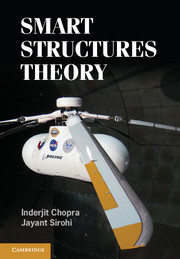Book contents
- Frontmatter
- Contents
- Preface
- 1 Historical Developments and Potential Applications: Smart Materials and Structures
- 2 Piezoelectric Actuators and Sensors
- 3 Shape Memory Alloys (SMAs)
- 4 Beam Modeling with Induced-Strain Actuation
- 5 Plate Modeling with Induced-Strain Actuation
- 6 Magnetostrictives and Electrostrictives
- 7 Electrorheological and Magnetorheological Fluids
- 8 Applications of Active Materials in Integrated Systems
- Index
- References
5 - Plate Modeling with Induced-Strain Actuation
Published online by Cambridge University Press: 18 December 2013
- Frontmatter
- Contents
- Preface
- 1 Historical Developments and Potential Applications: Smart Materials and Structures
- 2 Piezoelectric Actuators and Sensors
- 3 Shape Memory Alloys (SMAs)
- 4 Beam Modeling with Induced-Strain Actuation
- 5 Plate Modeling with Induced-Strain Actuation
- 6 Magnetostrictives and Electrostrictives
- 7 Electrorheological and Magnetorheological Fluids
- 8 Applications of Active Materials in Integrated Systems
- Index
- References
Summary
The previous chapter discussed the modeling of beam-like structures with induced-strain actuation. Many practical structures can be simplified and analyzed as beams, but such an assumption is not accurate in a large number of other structures, such as fuselage panels in aircraft, low aspect-ratio wings, and large control surfaces. It is possible to treat such structures as plates and perform a simple two-dimensional analysis to estimate their behavior. Some of the theories discussed in the previous chapter can be extended to two-dimensional plate-like structures. This chapter describes the modeling of isotropic and composite plate structures with induced-strain actuation. It will combine both the actuators and substrate into one integrated structure to model its behavior. The discussion focuses on induced-strain actuation by means of piezoceramic sheets, but the general techniques may be equally applicable to other forms of induced-strain actuation.
Plate analysis, including induced-strain actuation, is based on the classical laminated plate theory (CLPT), sometimes referred to as classical laminated theory (CLT). It is an equivalent single layer (ESL) plate theory in which the effects of transverse shear strains are neglected. It is valid for thin plates that have thicknesses of one to two orders of magnitude smaller than their planar dimensions (length and width). In the CLPT formulation, a plane-stress state assumption is used.
Classical Laminated Plate Theory (CLPT) Formulation without Actuation
A composite laminate consists of a number of laminae or plies, each with different elastic properties.
Information
- Type
- Chapter
- Information
- Smart Structures Theory , pp. 446 - 580Publisher: Cambridge University PressPrint publication year: 2013
